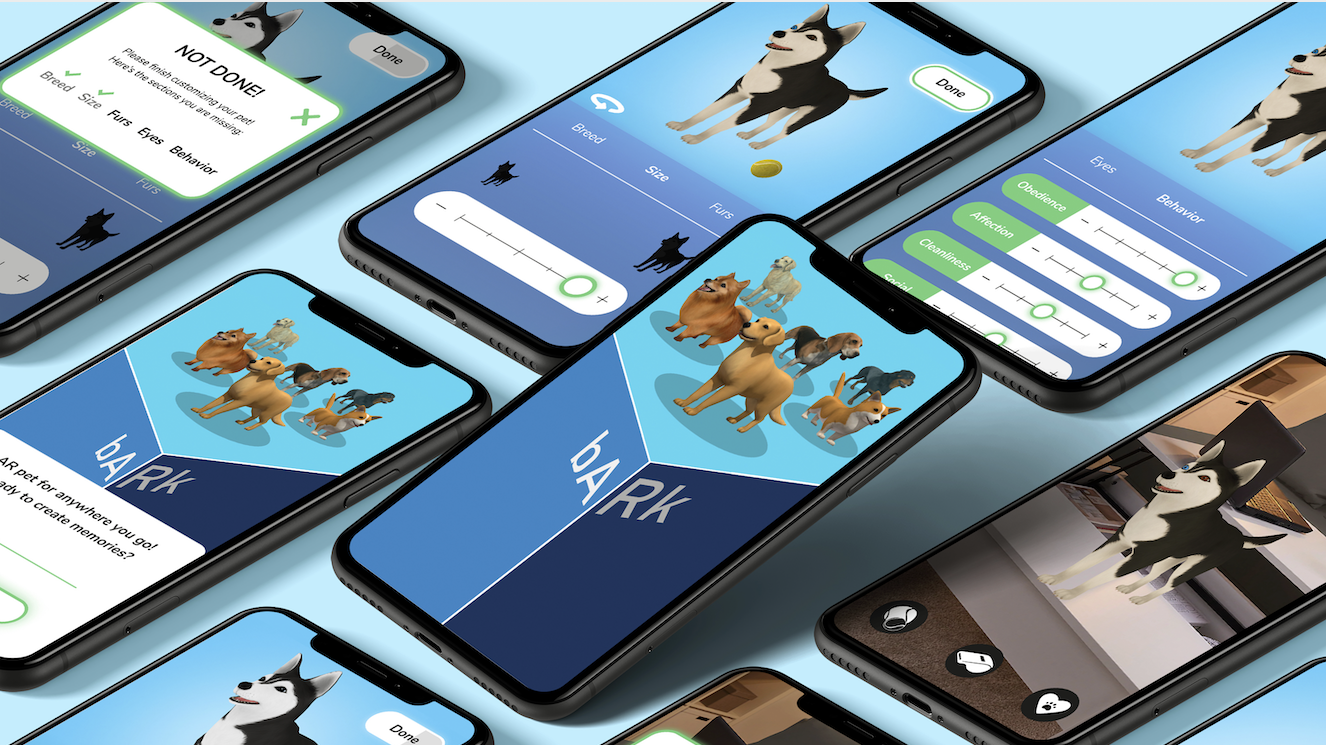
bARk: Augmented Reality Mobile App
September 2020 to March 2021

bARk is an augmented reality (AR) app that provides a virtual companion for animal-lovers. This relationship with a virtual pet provides both entertainment and emotional support to our users. What makes bARk special is it allows users to continue to create memories with their pet wherever they are. This application, designed by a team of undergraduate students studying Interactive Digital Media, is a high-fidelity Figma prototype of the onboarding process and a pet interaction screen with AR functionality developed in Unity.

The UX team was responsible for researching how a user’s experience differs on a mobile AR application versus a traditional mobile application. Research was also performed on how to best conduct usability tests when dealing with AR applications. The UX team focused on usability test scripts and creating card sorts to better understand our users’ thought processes about how they interpreted bARk’s interface. Our goal was to understand exactly how users think rather than assuming what a user might understand or like about the interface.
Importance of our design (the reason we are creating this product):
The UI team worked primarily in Figma iterating designs and prototypes to meet the deliverables set by the team. Every design decision made throughout the process has been based on research on the market’s leading trends as well as results from user testing conducted by the UX team. There was a lot of collaboration between the UI and UX teams, such that they both functioned as quality assurance for each other’s work. This constant flow of communication was key to successfully realizing the needs of our users within the timeframe we were given. Over the course of 6 months and 5 different prototypes, we were able to reach our goal of a high-fidelity Figma prototype.
bARk uses AR technology to place a digital pet into a user’s natural surroundings. With their pet in their pocket, users can interact through the bARk app at any point during the day. bARk gives its users an animal companion that can help to fill the void of a lost furry friend or give the pet owning experience to those with the inability to own a pet. Any pet lover with a device can interact with a bARk digital pet. This allows those who may be restricted by things like rental restrictions, lifestyle costs, or allergies to interact with and care for a cute and realistic furry friend.
The team used our extensive knowledge of UI and UX design and research methods to identify an innovative approach to AR. We began with little knowledge of development for AR. We spent the first half of the project researching and learning AR and solidifying our idea through the creation of wireframes. The team continued with their research in AR, and began working in Unity during the second half of the project to create a functional iOS build of the AR app. The team also refined the prototype wireframes and added features like microinteractions to create an enjoyable user experience.
The goal of bARk is to provide users with quick and easy access to a furry friend for emotional support, entertainment, and companionship. Over a period of six months, bARk’s team of six designers and developers have created a functional AR build and high-fidelity prototype.
bARk was developed for the technology and mobile applications industry. The team identified competition as Doggygotchi Go!, Dex, Planet AR, Nintendogs, Tamagotchi, Rover, and TamaDog!. Rover is an AR pet application limited to only a Corgi. The primary features of Rover include petting, playing with numerous toys, and feeding the dog. TamaDog! is an AR pet application limited to only a Basset Hound. The major features of TamaDog! include commanding your dog to perform tricks, with all content locked behind a paywall. Our research indicated that the industry does not have an abundance of realistic AR pet applications.
From the preliminary survey, we found that a large amount of the surveyors had a great love for pets and were interested in an app like bARk. We asked users questions about what they would like to see within an AR pet app like bARk and took their responses into consideration when developing our customization and interaction screens.
We are satisfied with the great amount of work that our team has done, but there are some things we could have done differently. Since most of the project was learning new software and learning new research methods, that took up the bulk of the beginning of the project. The ultimate idea for this app is a seamless flow between pet creation and pet interaction. The team chose to focus on experience over functionality, leading to a high-fidelity Figma prototype over a web build. With more time, this build could have been developed. Even if we were to restart this project, we would likely end with a Figma prototype again because of the large focus on the usability of this flow.
If we were to restart this project knowing what we know now, we would have started development in Unity during the first half of the project. Though the work in SparkAR provided knowledge easing the transition into Unity, it would have been beneficial to have the extra time to work in Unity expanding interaction functionality.
Though bARk did not turn out as extensive as originally proposed, bARk still turned out to be a success. We are very proud of our hard work, especially the fact that we learned how to use new software to build a functioning app from scratch. bARk successfully fulfills our initial goal of providing emotional support, entertainment, and companionship through a fun interactive experience. The extensive user testing and research that went into this build has created a great stepping stone to continue developing bARk to its fullest potential.